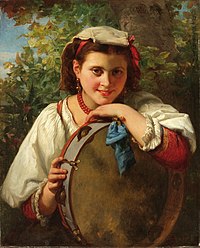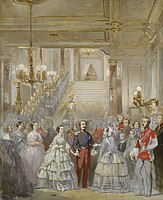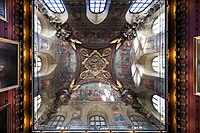|
Charles Louis Müller
 Charles Louis Müller (also known as Müller de Paris) (Paris 22 December 1815 – 10 January 1892 Paris) was a French painter. BiographyHe was the pupil of Léon Cogniet, Baron Gros and others in the École des Beaux-Arts. In 1837 he exhibited his first picture, Christmas Morning. From 1850 to 1853 he directed the manufactory of Gobelin tapestries. In 1864 he became a member of the Académie des Beaux-Arts of the Institut de France, succeeding Jean-Hippolyte Flandrin. WorksHe was a fecund producer of historic pictures and portraits. Among his works are Heliogabalus (1841), Primavera (1846), Haydée[1] (1848), Lady Macbeth, and his masterpiece, Calling Out the Last Victims of the Reign of Terror at the Prison of Saint-Lazare (Appel des dernières victimes de la Terreur dans la prison de Saint-Lazare), with portraits of the most illustrious victims).[2][3][4] Also notable are Vive l'Empereur, based on a poem by Méry about an episode in the battle before Paris, March 30, 1814 (1855), Marie Antoinette (1857), A Mass During the Reign of Terror (1863), Desdemona (1868), Lanjuinais at the Tribune (1869), The Madness of King Lear (1875), Charlotte Corday in Prison[5] (1875), Mater Dolorosa (1877), The Martyrdom of St. Bartholomew and The Massacre of the Innocents. He executed frescoes for the Salle d'État and the Galerie d'Apollon in the Louvre,[6] and for the ceiling of the Salon Denon.[7] Gallery (chronological)
References
Sources
External linksWikimedia Commons has media related to Charles-Louis Müller.
|
||||||||||||||
Portal di Ensiklopedia Dunia

![Calling Out the Last Victims of the Terror at Saint Lazare Prison on the 7-9 Thermidor, Year II [25-27 July 1794] (1850), Musée de la Révolution française](http://upload.wikimedia.org/wikipedia/commons/thumb/0/02/Beaux-Arts_de_Carcassonne_-_Appel_des_derni%C3%A8res_victimes_de_la_terreur_dans_la_prison_de_saint_Lazare.7%2C_9_thermidor_1794_-_Charles_Louis_MULLER.jpg/200px-Beaux-Arts_de_Carcassonne_-_Appel_des_derni%C3%A8res_victimes_de_la_terreur_dans_la_prison_de_saint_Lazare.7%2C_9_thermidor_1794_-_Charles_Louis_MULLER.jpg)




![Charlotte Corday in Prison (1875), vintage postcard of the painting of unknown location[5]](http://upload.wikimedia.org/wikipedia/commons/thumb/0/0f/Charlotte_Corday_in_Prison%2C_Charles_Louis_Muller_%28NYPL_b12647398-70557%29_%28cropped%29.tiff/lossy-page1-153px-Charlotte_Corday_in_Prison%2C_Charles_Louis_Muller_%28NYPL_b12647398-70557%29_%28cropped%29.tiff.jpg)
